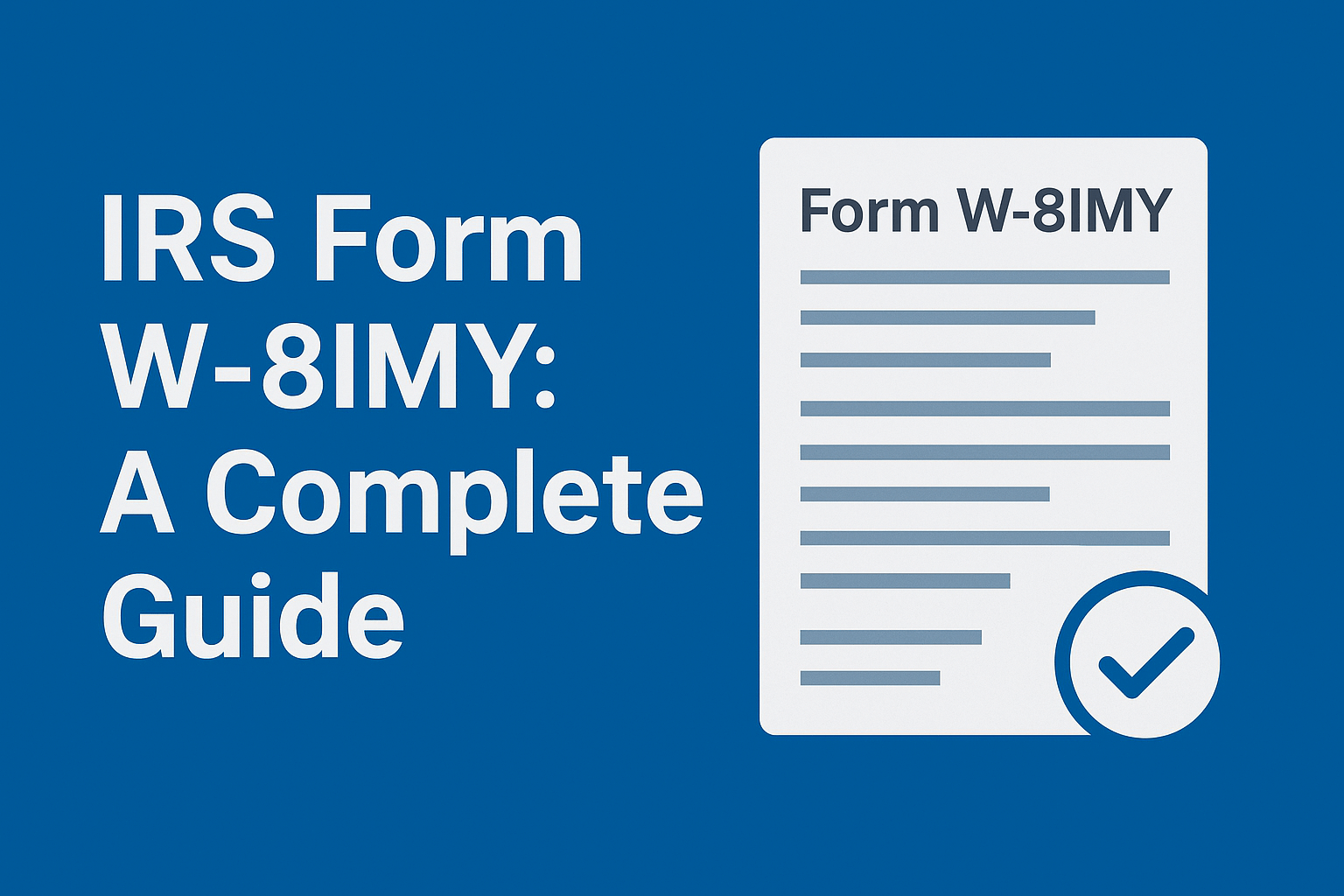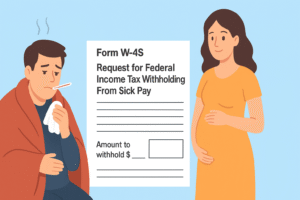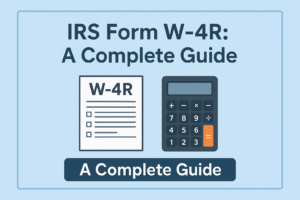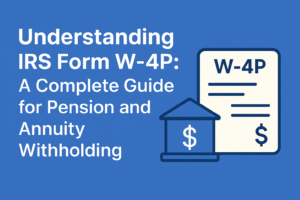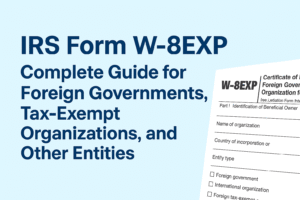Businesses and financial institutions engaged in cross-border transactions often deal with complex IRS withholding and reporting requirements. Among the various W-8 forms, Form W-8IMY plays a critical role for entities that act as intermediaries, partnerships, or certain flow-through entities. Unlike Forms W-8BEN or W-8BEN-E (which identify beneficial owners), Form W-8IMY is used to certify the status of intermediaries that receive payments on behalf of others.
In this guide, we’ll explore the purpose of Form W-8IMY, who must file it, related tax concepts such as beneficial ownership, FATCA classifications, and line-by-line instructions to complete the form correctly.
Purpose of Form W-8IMY
Form W-8IMY, Certificate of Foreign Intermediary, Flow-Through Entity, or Certain U.S. Branches for United States Tax Withholding and Reporting, is used by foreign and certain U.S. entities that act as:
- Intermediaries (e.g., banks, brokers) receiving payments on behalf of others.
- Flow-through entities (e.g., partnerships, trusts) where the income is ultimately taxed to partners or beneficiaries.
- Certain U.S. branches of foreign banks or insurance companies treated as U.S. persons for withholding purposes.
The form certifies the entity’s Chapter 3 and Chapter 4 status under the Internal Revenue Code (IRC). It also ensures proper tax treatment and prevents unnecessary withholding at a 30% rate on U.S.-sourced income.
Who Needs to Submit Form W-8IMY?
Form W-8IMY must be submitted by entities that:
- Act as Intermediaries
- Foreign financial institutions (FFIs) or non-financial intermediaries receiving payments for another party.
- Examples: Custodian banks, clearing organizations, or brokers.
- Are Flow-Through Entities
- Partnerships or simple trusts where the tax liability passes to the partners or beneficiaries.
- Example: A Cayman Islands partnership investing in U.S. securities.
- Are Certain U.S. Branches
- U.S. branches of foreign banks or insurance companies that agree to be treated as U.S. persons for withholding.
Who is a Beneficial Owner?
A beneficial owner is the person or entity that ultimately owns or enjoys the benefits of an income stream, even if the payment is received through an intermediary.
- For example, if a U.S. corporation pays dividends to a foreign bank (acting as an intermediary), but the income is really for the foreign investors holding accounts at the bank, the investors are the beneficial owners—not the bank.
Form W-8IMY itself is not used to certify beneficial owner status; instead, the intermediary provides Forms W-8BEN, W-8BEN-E, or W-9 for each beneficial owner along with Form W-8IMY.
What is Chapter 4 Status?
Chapter 4 of the IRC implements FATCA (Foreign Account Tax Compliance Act) rules. Entities filing Form W-8IMY must declare their FATCA classification, such as:
- Participating FFI (Foreign Financial Institution) – complies with FATCA reporting.
- Registered Deemed-Compliant FFI – meets criteria to avoid full FATCA compliance.
- Nonparticipating FFI – subject to 30% FATCA withholding.
- Non-Financial Foreign Entity (NFFE) – either active or passive (explained later).
Correctly declaring Chapter 4 status is crucial to avoid excess FATCA withholding.
What is Chapter 3 Status?
Chapter 3 of the IRC deals with withholding on payments of U.S.-source income to foreign persons. Entities filing Form W-8IMY must certify whether they are:
- A Qualified Intermediary (QI) – an intermediary with a withholding agreement with the IRS.
- A Nonqualified Intermediary (NQI) – no IRS agreement, passes information upstream.
- A Withholding Foreign Partnership (WP) or Withholding Foreign Trust (WT) – assumes withholding responsibility.
- A Nonwithholding Foreign Partnership (NWP) or Nonwithholding Foreign Trust (NWT) – provides documentation for each partner/beneficiary.
How Often Do You Need to Submit a Form W-8IMY?
- Form W-8IMY is generally valid until the last day of the third calendar year after the year it is signed (e.g., a form signed in 2025 remains valid through December 31, 2028).
- However, a new form must be submitted if:
- Any information becomes incorrect.
- The entity’s Chapter 3 or Chapter 4 status changes.
How to Fill Out Form W-8IMY: Line by Line Instructions
Part I – Identification of Entity
| Line | What You Enter | Details / Guidance |
| 1 | Name of Organization | Full legal name exactly as registered (include Inc., Ltd., SA, etc.). |
| 2 | Country of Incorporation / Organization | Write the country where the entity was created or legally registered. |
| 3 | Name of Disregarded Entity (if applicable) | If a single-owner entity is treated as disregarded for U.S. tax, put that name here. Leave blank otherwise. |
| 4 | Chapter 3 Status | Check one: QI, NQI, WP, WT, NWP, NWT. This determines who is responsible for withholding and reporting. |
| 5 | Chapter 4 (FATCA) Status | Choose from FFI, Participating FFI, Registered Deemed-Compliant FFI, Sponsored FFI, Active NFFE, Passive NFFE, etc. |
| 6 | Permanent Residence Address | Street, city, province, postal code, country. No P.O. boxes. |
| 7 | Mailing Address | If different from line 6; otherwise leave blank. |
| 8 | U.S. TIN | If the entity has a U.S. Employer Identification Number (EIN) or other TIN, provide it. |
| 9a | Foreign TIN (FTIN) | Mandatory unless the entity’s jurisdiction does not issue one or an exception applies. |
| 9b | GIIN (Global Intermediary Identification Number) | Needed for FFIs or sponsoring entities registered under FATCA. |
| 10 | Reference Number(s) | Optional internal reference (e.g., account number for which this form is provided). |
| 11 | Date of Birth | Individuals only; most entities leave blank. |
Part II – Qualified Intermediary (QI)
Completed only if the entity is a Qualified Intermediary with an IRS QI Agreement.
- Line 12–14 – Enter your QI EIN and certify you have a valid agreement.
- Indicate whether you assume primary withholding responsibility or only documentation forwarding.
Part III – Nonqualified Intermediary (NQI)
For intermediaries without a QI Agreement.
- Attach to the withholding agent:
- This completed W-8IMY
- Beneficial owner documentation (W-8BEN, W-8BEN-E, or W-9 forms)
- A withholding statement allocating income to each owner.
Part IV – Withholding Foreign Partnership (WP) / Part V – Withholding Foreign Trust (WT)
- Indicate WP or WT EIN.
- Certify that the partnership or trust assumes primary withholding and reporting responsibility on U.S. income.
Part VI – Nonwithholding Foreign Partnership (NWP) / Part VII – Nonwithholding Foreign Trust (NWT)
- Certify that you are a foreign partnership or trust not assuming withholding; you must provide a withholding statement and beneficial owner forms.
Part VIII – Certain U.S. Branches
- U.S. branches of foreign banks/insurers electing to be treated as a U.S. person for withholding complete this section.
- Provide the U.S. EIN for the branch and check whether you will assume withholding and reporting.
Parts IX–XX (Other FATCA / Chapter 4 Classifications)
These sections correspond to specialized Chapter 4 statuses such as:
- Participating FFI (Including Reporting Model 2 FFI)
- Registered Deemed-Compliant FFI (including Model 1 Reporting)
- Sponsored FFI
- Territory Financial Institution
- Direct Reporting NFFE
- Sponsored Direct Reporting NFFE
- Trustee-Documented Trust, etc.
Check only the part that matches your FATCA status and complete the certification language inside that part.
Withholding Statement
Although not physically on the form, an up-to-date withholding statement must accompany W-8IMY when:
- Acting as an NQI, NWP, or NWT.
- Allocating each income item to the appropriate beneficial owner.
This statement lists:
- Owner’s name, address, TIN/FTIN
- Allocation percentages
- Type of income
Part XXI – Certification
- Printed Name, Title, Signature – Authorized officer or partner signs under penalties of perjury.
- Date – Use the correct format (MM/DD/YYYY).
- Capacity – e.g., “Compliance Officer,” “Managing Partner,” “Trustee.”
A typed signature is not valid unless specifically allowed by the withholding agent.
What Happens If You Miss Submitting Form W-8IMY?
Failure to provide Form W-8IMY can result in:
- 30% withholding tax on U.S.-sourced income (dividends, interest, royalties, etc.).
- Possible misclassification as a Nonparticipating FFI under FATCA.
- Disruption in financial transactions, delayed payments, or account restrictions.
Frequently Asked Questions on IRS Form W-8IMY
1. Is Form W-8IMY the same as Form W-8BEN or W-8BEN-E?
No. Form W-8BEN/W-8BEN-E is for beneficial owners of income (individuals or entities). Form W-8IMY is for intermediaries, flow-through entities, and certain U.S. branches that receive income on behalf of others.
2. When should an intermediary provide Form W-8IMY to a withholding agent?
As soon as it opens an account, receives U.S.-sourced income, or before the first reportable payment. Timely submission avoids automatic 30% withholding.
3. How long is Form W-8IMY valid?
It generally remains valid through the last day of the third calendar year after it is signed, unless a material change (e.g., status change, address change) occurs earlier.
4. Do foreign partnerships always need to file Form W-8IMY?
Yes, if the partnership is receiving U.S.-source income through a U.S. withholding agent and wants to certify its Chapter 3 and Chapter 4 status or allocate income to partners using owner documentation.
5. Can an individual complete Form W-8IMY?
No. This form is for entities only. Individuals use Form W-8BEN to certify foreign status and claim treaty benefits.
6. What happens if the withholding agent never receives a valid Form W-8IMY?
The agent must treat the entity as an undocumented payee, applying 30% withholding on U.S.-sourced payments (and potentially FATCA withholding). This can also trigger reporting mismatches.
7. Do I need to provide supporting documentation with Form W-8IMY?
Yes, if acting as an NQI, NWP, or NWT, attach:
- A withholding statement allocating income
- Valid beneficial owner forms (W-8BEN, W-8BEN-E, or W-9)
8. Does Form W-8IMY require a U.S. TIN?
A U.S. TIN (EIN) is required if you are a withholding foreign partnership/trust, a QI, or a U.S. branch electing U.S. person status. Other intermediaries usually do not need one.
9. What is the difference between Chapter 3 and Chapter 4 on Form W-8IMY?
- Chapter 3 deals with withholding on FDAP income (fixed, determinable, annual, or periodical) for foreign persons.
- Chapter 4 enforces FATCA rules, classifying entities as FFIs, NFFEs, or exempt beneficial owners.
10. How does FATCA affect intermediaries filing Form W-8IMY?
Under FATCA, intermediaries must declare their Chapter 4 (FATCA) status, provide a GIIN if an FFI, and identify substantial U.S. owners if a passive NFFE. Failure may result in FATCA withholding.
11. Can Form W-8IMY be submitted electronically?
Many financial institutions accept digitally signed PDFs or secure portal submissions, but always confirm with the withholding agent’s policy.
12. Is an FTIN mandatory on Form W-8IMY?
Generally yes, unless:
- The jurisdiction does not issue FTINs, or
- IRS exceptions apply.
An FTIN helps tax authorities cross-match records internationally.
13. What’s the difference between Active and Passive NFFE in practice?
An Active NFFE is an operating business (manufacturing, services) where passive income is <50%. A Passive NFFE is primarily an investment/holding entity and must disclose substantial U.S. owners.
14. Are retirement plans always exempt under FATCA?
Many governmental and broad-based retirement plans qualify as exempt beneficial owners and may provide Form W-8BEN-E or Form W-8IMY depending on whether they act as intermediaries.
15. What is FTIN?
Foreign Taxpayer Identification Number (FTIN) is the taxpayer ID issued by an entity’s country of residence.
- Required in Line 9a unless an exception applies.
- Used for international tax compliance and matching records with foreign tax authorities.
16. What is FFI?
Foreign Financial Institution (FFI) refers to non-U.S. entities such as banks, investment funds, brokers, or insurance companies that accept deposits, hold financial assets, or trade in securities.
17. What is NFFE?
Non-Financial Foreign Entity (NFFE) is a foreign entity that is not an FFI.
- Active NFFE – earns less than 50% passive income (e.g., operating companies).
- Passive NFFE – earns 50% or more passive income (e.g., holding companies).
18. What are Exempt Retirement Plans?
Certain retirement funds are treated as exempt beneficial owners under FATCA and do not face withholding. Examples include:
- Government retirement funds.
- Broad-based retirement funds regulated by the home country.
- Pension funds of international organizations.
Such entities may still use Form W-8IMY to certify exempt status if acting as an intermediary.
Final Thoughts
IRS Form W-8IMY is more than a routine compliance document—it’s the cornerstone of correct withholding and reporting when U.S.-source income passes through intermediaries, partnerships, and trusts. Properly identifying Chapter 3 and Chapter 4 status, attaching the right beneficial owner documentation, and maintaining current records help:
- Avoid unnecessary 30% backup withholding
- Protect FATCA compliance for all parties
- Prevent IRS scrutiny and costly corrections
For entities managing international investments, understanding and periodically reviewing your W-8IMY process is critical. Build an internal checklist, maintain clear withholding statements, and refresh the form before it expires. Correct documentation not only ensures tax efficiency but also builds trust with withholding agents and investors alike.

